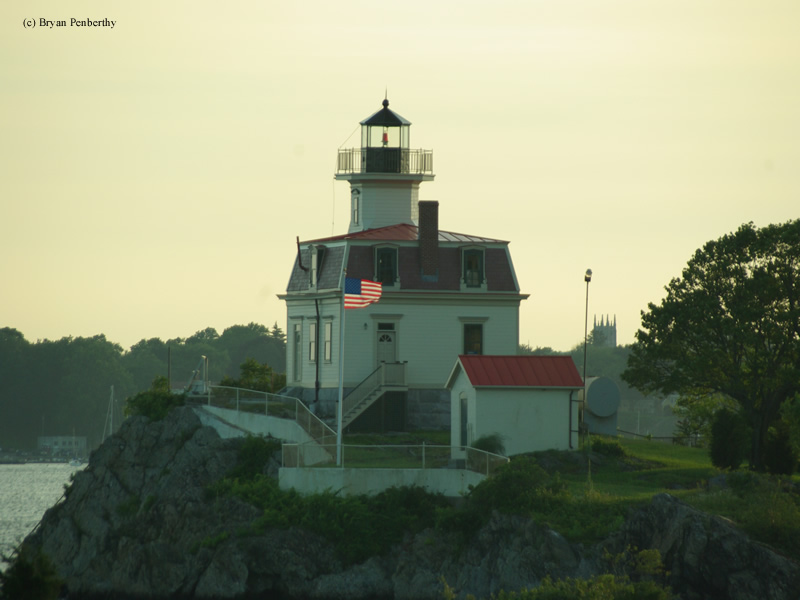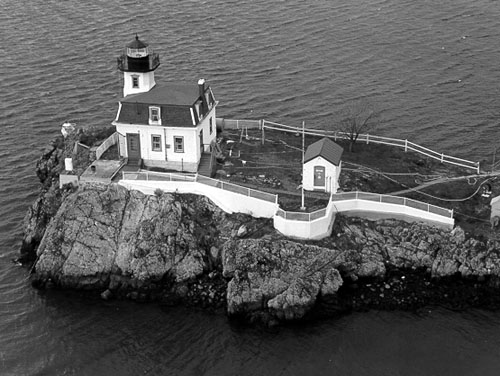Pomham Rocks Lighthouse
East Providence, Rhode Island - 1871 (1871**)

History of the Pomham Rocks Lighthouse
Posted/Updated by Bryan Penberthy on 2013-01-04.
Due to thriving commerce, there was an uptick in shipping traffic heading in and out of Providence. The Lighthouse Board felt it was necessary to more adequately mark the Providence River to provide safe passage. Starting in 1868, the Lighthouse Board approved the construction of the Conimicut Lighthouse at the mouth of the Providence River. On July 15, 1870, Congress appropriated $20,000 for three additional lighthouses in the area. They were Fuller Rock, Sassafras Point, and Pomham Rocks.
Built upon Pomham Rock, an island of approximately one-half-acre sitting less than a mile from shore, the lighthouse was an eight-room wood-framed dwelling with a mansard roof very similar to Rhode Island's Rose Island Lighthouse. The wooden tower rose from the front of the structure allowing the keeper to access the lantern from the second floor. Illumination was provided by a sixth-order Fresnel lens displaying a fixed white light that was first shown on the night of December 1, 1871. This was changed to a fixed red light in 1873.
C. H. Salisbury was the first keeper assigned to Pomham Rocks. A year later, in 1872, his wife Mary applied for appointment as assistant keeper, but was denied. She would later be appointed acting keeper upon the death of her husband in 1893.
It appears that early on in the station's history, it was sometimes referred to as Pumham Rock as evidenced in the Annual Report of the Lighthouse Board dated 1878. This entry shows that a new barn was built, the boat landing was repaired, and the roof was replaced.
143. Pumham Rock, east side of Providence River, Rhode Island - The dwelling-house has been reshingled and in part resheathed, new barn built, landing repaired, and painted throughout, putting it in thorough good order.
By 1899, the Lighthouse Board was planning to establish a fog signal at Pomham Rocks as evidenced by the entry in the Annual Report of the Lighthouse Board dated 1899:
203. Pomham Rocks, Providence River, Rhode Island - The preparation of the blower siren signal for this station was taken in hand. Repairs were made.
A blower siren operated by a two-and-one-half horsepower oil engine was established on June 30, 1900. It didn't take long for locals to complain. One newspaper ran the headline "THE GREATEST NUISANCE IN THE HISTORY OF THE STATE."
The fog signal was a continuous blast when operated, which many mariners felt made it hard to locate in the fog. Recommendations were made to replace the blower siren with a fog bell, but there was already a fog bell in operation at the nearby Sabine Point Lighthouse which might cause confusion amongst mariners.
It didn't last a year before the Lighthouse Board changed its characteristic. The Annual Report of the Lighthouse Board dated 1901 had the following entry:
213. Pomham Rocks, Rhode Island - On June 15, 1901, the characteristic of the fog-signal was changed from a continuous blast to blasts of 3 seconds' duration, separated by silent intervals of 12 seconds. A brick oil house was built, and the fog-signal apparatus was overhauled. Minor repairs were made.
The blower siren was removed by 1902, and a fog bell was put in place at Pomham Rocks after all.
 Pomham Rocks Lighthouse (Courtesy Coast Guard)
Pomham Rocks Lighthouse (Courtesy Coast Guard)
Although the lighthouse wasn't far from shore, the lighthouse featured very few amenities that the locals had. Basic things that many of us take for granted today, such as electricity, running water, and telephone were not available at the lighthouse. This wouldn't change for a long time.
A cistern would provide water. Eventually a telephone line would be run to the lighthouse in 1940, and by sometime in the 1950s, electricity would be provided.
The sixth-order Fresnel lens would be upgraded to a higher powered fourth-order Fresnel lens in 1939 illuminated by incandescent oil vapor. It would be removed in 1974 when the light was extinguished. It is currently on display at the Custom House Maritime Museum in Newburyport, Massachusetts. The lighthouse duties were taken over by an automated light on a skeletal tower.
The lighthouse was deemed excess property, and in 1980, the General Service Administration put the lighthouse up for auction. When the bids were opened, the Mobil Oil Company's high bid of $40,100 was accepted.
By 2005, ExxonMobil Corporation had signed a long term lease with the Friends of Pomham Rocks Lighthouse, a chapter of the American Lighthouse Foundation. That year, ExxonMobil has donated $50,000 towards the restoration of the lighthouse.
The Friends of Pomham Rocks Lighthouse signed a $283,000 contract with Abcore Restoration Company in 2005 for the restoration of the aging lighthouse. Abcore Restoration Company had conducted the amazing transformation of the Plum Beach Lighthouse back in 2003. By 2006, the restoration was complete, and the tower was relighted on July 30.
In recognition of the hard work and dedication of the Friends of Pomham Rocks has put for over the years, ExxonMobil has donated the lighthouse to the American Lighthouse Foundation and the Friends of Pomham Rocks. This will allow the group to continue the restoration and preservation of the lighthouse for future generations.
Reference:
- Northeast Lights - Lighthouses and Lightships, Robert G. Bachand, 1989.
- America's Atlantic Coast Lighthouses (6th edition), Jeremy D'Entremont, 2005.
- Annual Report of the Light House Board, U.S. Lighthouse Service, Various years.
- American Lighthouse Foundation website.
- New England Lighthouses: A Virtual Guide website.
Directions: The best view of the Pomham Rocks Lighthouse is from the East Bay Bicycle Path. Parking for the path is on Bullocks Point Ave. and Washington Street. The parking lot is a small lot on the east side of Bullocks Point Ave. After parking, walk north about a quarter of a mile. The trees will open up allowing for great views.
You can also see the lighthouse from Crest Ave. just off Bullocks Point Ave. The views from this street are tough as the lights from the pollution control facility end up in most shots.
Access: Grounds and tower closed.
View more Pomham Rocks Lighthouse picturesTower Height: 40.00'
Focal Plane: 54'
Active Aid to Navigation: Deactivated (1974)
*Latitude: 41.77800 N
*Longitude: -71.36900 W
See this lighthouse on Google Maps.
